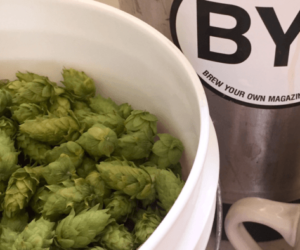Oxygenating Wort: Tips from the Pros
Brewer: Dean Mochizuki, Pike Brewing Company in Seattle, WA
To oxygenate our beers at Pike, we use an inline oxygen stone located on the output side of our heat exchanger using medical grade oxygen. The main difference in aerating on a commercial scale and doing it at home in small batches is the amount of oxygen used and the delivery system used. At the homebrew level there are in-line oxygenation systems that should work very well for small batches.
Generally speaking, beers with a higher starting gravity require more oxygen due to wort density and yeast pitching rates. We try to aim for 8–10 mL of oxygen per liter of wort in our beers. We don’t measure ppm as we do not have a DO (dissolved oxygen) meter. For higher gravity beers we do try to go a little higher. Homebrewers in a club can invest in a meter to share as they are around $250 to $350 each.
Over oxygenation and under oxygenation are the most common mistakes brewers make. Over oxygenation can stress the yeast and under oxygenation can lead to too long a lag time and sluggish fermentations. Repetition and knowing the requirements of your yeast are vital to achieving consistent results.
On the homebrewing level, using a small aeration stone available from your homebrew store and an oxygen tank purchased at your local home improvement store would work very well, as would an aquarium pump with an in-line filter and an aeration stone. Shaking or stirring your cooled wort does work but your results could be more hit and miss.
Brewer: Luther Paul, Lakefront Brewery in Milwaukee, WI
At Lakefront, the cooled wort traveling from the whirlpool to the fermenter has pure oxygen injected inline through a cintered metal candle. Shortly after, yeast is pitched in-line. Everything has a chance to mingle on the way to the fermenter. A flow meter controls the rate of oxygen that is injected.
Every beer is different and requires its own level of aeration. We adjust the amount of aeration depending on temperature, wort flow rate and gravity. All of these factors have an effect on the amount of oxygen that dissolves. We can measure the amount of oxygen both in-line and in the fermentation tank using a dissolved oxygen meter. The standard is 8–10 ppm. We tend to repitch our yeasts up to ten generations depending on the yeast. Adequate oxygen during pitching keeps our yeast healthy. However, this is probably not as important on a homebrew scale if the yeast is not being repitched.
There really isn’t a difference between aerating commercial-sized brews and homebrewing. Batch size doesn’t matter. It’s all about having adequate dissolved oxygen to promote healthy yeast growth. Homebrewers are innovative. I’ve seen setups that rival pilot-scale breweries complete with miniature oxygen-injecting candles. But there’s nothing wrong with shaking a carboy or using an aerating racking cane.
Remember — the only time oxygen is introduced is in the early stages of fermentation. Yeast can quickly consume it. In any other stage of the brewing process, oxidation can really deteriorate the quality of the beer. Also, keep it sanitary. The yeast will reward you.
Brewer: Kyle Larsen, Double Mountain Brewery and Taproom in Hood River, OR
At Double Mountain we use pure oxygen which is pumped through a stainless steel diffusion stone once the wort is cooled. It is pumped into the wort for the entire process of filling the fermenter.
Every beer you produce should garner the same vital attention to oxygenation. Healthy fermentation is a key concern in brewing. Without healthy fermentation you risk contamination, under attenuation and off flavors. Oxygenating your wort is one of many important steps you can take to ensure healthy fermentation. It helps yeast synthesize essential substances, mainly fatty acids and sterols, needed for optimum cell division. Generally, the more yeast cell growth the cleaner, faster, and more complete the fermentation will be.
At Double Mountain we don’t measure dissolved oxygen content. The amount of oxygen added has been adjusted according to fermentation results. We watch a sight glass, which is inline after the diffusion stone, to ensure that the wort is fully saturated with oxygen. We adjust the flow of oxygen according to the look of the wort running through the sight glass.
As a homebrewer you can essentially oxygenate your wort the same way as we do at Double Mountain. The simplest way to replicate this process is to flow oxygen through a diffusion stone into the wort of your full fermentation vessel. Run the oxygen for a couple of minutes, give or take, depending on the initial gravity. I’m not too concerned with over oxidizing the wort. It is possible and levels over 40 ppm could affect the outcome of the final product. As long as you remember to turn the oxygen off in a timely manner you should have no problems.
The biggest mistake you can make when oxygenating is using dirty equipment. Pay extra attention to cleaning your diffusion stone; it is an ideal place for bugs and bacteria to grow. Always clean and sanitize your stone after each use to avoid problems. I store my homebrew diffusion stone in sanitizer to ensure it remains sanitized in-between batches. You can store your stone dry, just be sure to clean and sanitize it before using it again.



